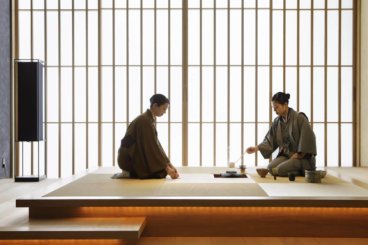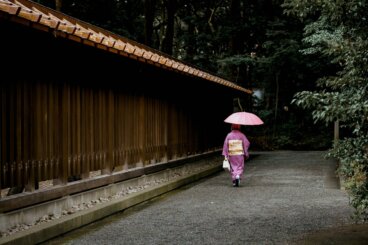The good news for travelers is that there is no single best time of year to travel to Japan — yet this makes it hard to decide when to visit, as each season has its own special highlights.
When planning a trip to Japan, a key question to ask yourself is: would you rather have better weather, or fewer tourists around? After all, some travelers hate the cold, or the heat and humidity of summer, while others will do whatever it takes to avoid crowds!
The best time to visit Japan, particularly when it comes to weather, is generally considered to be spring, between March and May, or fall, around October and November. However, other times of year have the benefit of being less crowded and also offer seasonal activities like summer matsuri (festivals) and winter onsen (hot springs), skiing, and snowboarding.
Because there are so many factors to consider, we’ve put together this comprehensive guide on the best time to travel to Japan, including information on the seasons, weather, national holidays to look out for, and more.
We update this page regularly and it was last updated on September 26, 2022.
The Seasons and When to Visit Japan
- Japanese Seasons 101
- Japan’s National Holidays and Peak Travel Seasons
- Spring in Japan
- Summer in Japan
- Fall in Japan
- Winter in Japan

Japanese Seasons 101: The Basics
Japan is truly a year-round destination, and Japanese culture is remarkable in its profound appreciation of the changing of the seasons. As you’ll see when you visit, each season — and even sub-season — is celebrated with seasonal foods, and often festivals. Because of this, we typically recommend taking advantage of any chance to visit Japan.
Highlights of Japan’s Seasons
- Spring is famous for the cherry blossom season, and if you’re lucky — and don’t mind the crowds — you may experience hanami (cherry-blossom viewing) in all its glory. This romantic time of year is popular for honeymoons in Japan.
- Summer is arguably the most festive time of year, with colorful matsuri throughout the country, the chance to hike in the mountains, and lovely coastal areas where you can enjoy the sea.
- Fall is another magical (and highly popular) time of year, with brilliant autumn colors and crisp, pleasant temperatures.
- Winter offers amazing seafood, incredible hot springs, not to mention some of the best powder in the world for skiing and snowboarding.
Weather in Japan by Month
- January (after the New Year’s holidays) and February can be great if you don’t mind the cold, because there are usually very few tourists (with the notable exception of Chinese New Year).
- Late March and early April (cherry blossom season) are beautiful, but it’s one of the most crowded and expensive times of year.
- Mid to late May is great, with pleasant weather and not so many crowds.
- June can be nice, but is often rainy (and humid).
- July and August are very hot and humid, but also lively with lots of festivals.
- Mid to late September can be nice (if hot), with fewer tourists than summer or fall, though typhoons can sometimes affect plans.
- October and November have very pleasant autumn weather, but also crowds rivaling spring (especially for the fall foliage in November).
- Early December can be great if you don’t mind some cold, but mid to late December gets very crowded for New Year’s.
How Geography Affects Seasons and Weather in Japan
When discussing the weather in Japan, it’s also helpful to have a very basic understanding of the country’s geography. While Japan may look rather small on the map — especially next to a massive country like China — it is surprisingly large.
The most important thing to keep in mind is that seasons and weather in Japan vary a lot from place to place. Japan stretches from the frigid northern island of Hokkaido, all the way to the subtropical islands of Okinawa in the far southwest.
As you can likely imagine, Hokkaido experiences longer and more pronounced winters than the rest of Japan. In contrast, Okinawa enjoys longer summers and relative warmth almost year-round. In between — in places like Tokyo and Kyoto, on Japan’s main island of Honshu — things tend to be less extreme.
Generally speaking, locations to the south and west tend to be slightly warmer, while locations to the north and east tend toward being cooler. Also keep in mind that higher-elevation areas, such as the Japanese Alps, tend to be colder as well.
For the purposes of this article, to keep things as simple as possible, the information below is primarily based on the seasons and weather in Honshu — and specifically places like Tokyo and Kyoto.
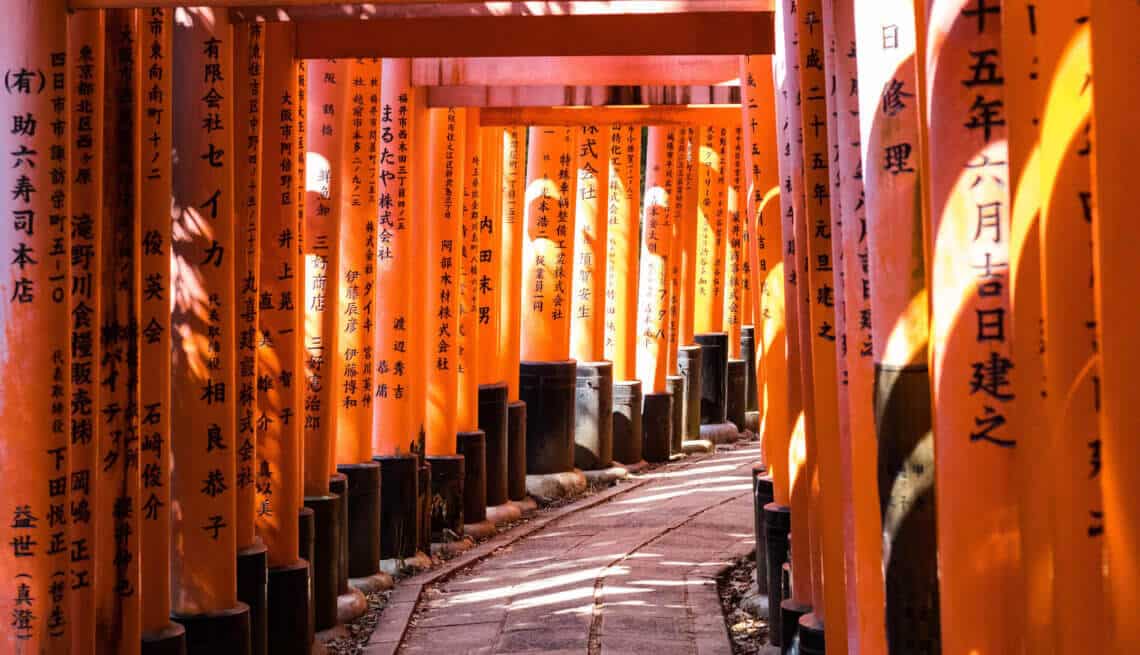
Japan’s National Holidays and Peak Travel Seasons
Despite Japan’s popularity, it is possible, to some extent, to avoid crowds at any time of year. Of course, this requires making a special effort to explore at “off” hours, such as early in the morning, or focus on off-the-beaten-path places, as opposed to popular tourist spots.
But if you really want to feel like you have Japan to yourself (to a degree, at least!), the best option is to avoid visiting during any of Japan’s peak seasons.
Japan’s Peak Travel Seasons
Here is a short list of the most crowded times of year in Japan. In addition to crowds, it’s safe to expect the price of accommodations at hotels and ryokans to skyrocket during these peak travel periods:
- New Year’s: From around the last week of December, into the first week of January.
- Chinese New Year: The exact dates vary each year, typically falling in late January or February.
- Cherry Blossom Season: From around the second half of March, into the first half of April.
- Golden Week: An extended holiday week that usually occurs in the first week of May.
- Obon: An extended holiday period that usually occurs in the middle of August.
- National Holidays: Various long weekends occurring throughout the year.
Japanese people love to travel and will take advantage of any holiday weekend to travel domestically, leading to high demand.
See upcoming dates and tips for planning a trip during peak seasons in our guide to traveling during Japanese holidays.
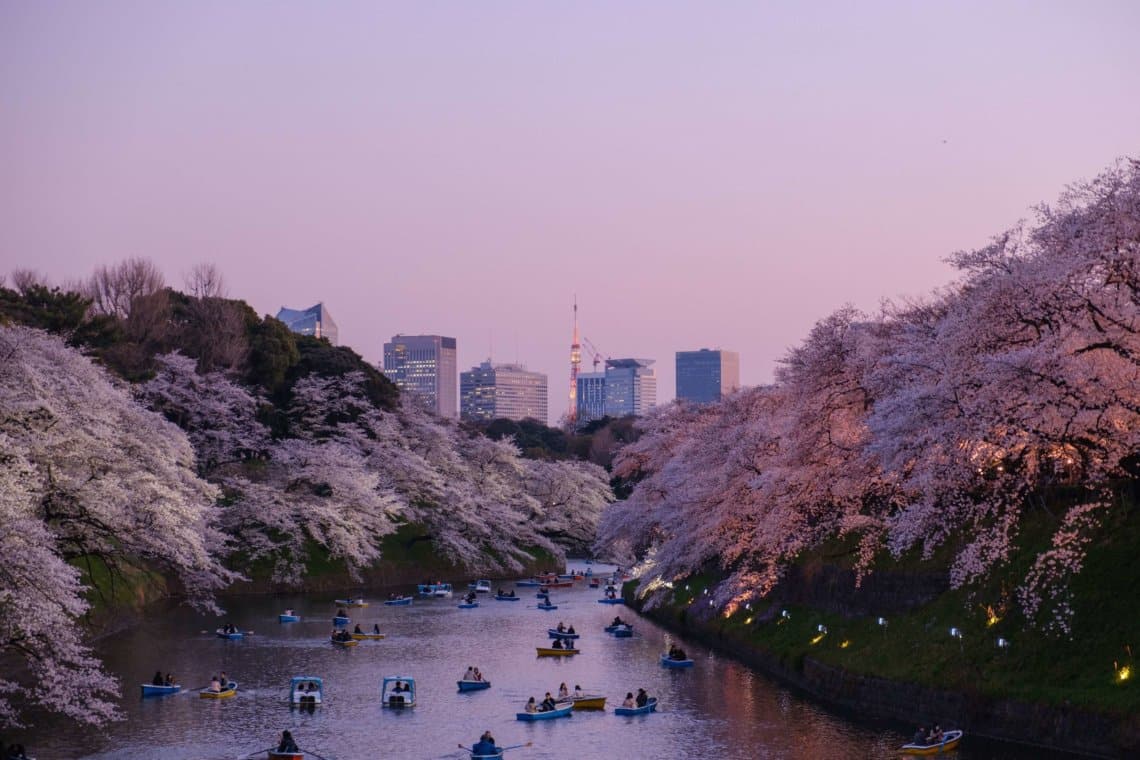
Spring in Japan
Ah, spring.
Spring in Japan lasts from about mid-March to May, depending on the location. The weather in spring is notoriously fickle, with temperatures ranging from approximately 40 to 65 °F (4 to 18 °C). On some days you may still want your winter coat, while on other days you may not even need a sweater.
Spring is Japan’s most famous season, and is symbolized by the iconic sakura (cherry blossoms), which typically bloom sometime between the second half of March, and the first half of April (sakura bloom schedules, too, vary significantly depending on location).
Without a shadow of a doubt, we receive far more inquiries for travel to Japan around cherry blossom season than for any other time of year. In fact, it is such a popular time to visit that we are often forced to stop even considering new inquiries months and months in advance.
While the beauty of the cherry blossoms in bloom is undeniably alluring, whether or not flower viewing in Japan is worth the potential downsides is not quite as clear!
Would-be travelers to Japan often try to coordinate their trips to coincide with hanami season, but Mother Nature is unpredictable. In some years, the sakura bloom early, and in others they arrive late; in “lucky” years they might linger on the trees for a couple of weeks, while in others a strong wind or rain may scatter them early.
Of course, it is in great part this unpredictability and impermanence that has provided inspiration to Japanese poets for centuries.

Why You Might Want to Avoid Cherry Blossom Season
First, a confession: we can’t deny that cherry blossom season can be amazing. The question is whether or not it’s worth the trouble, added expense, and endless crowds.
Apart from their unpredictability (alluded to above), the problem with the blossoms is that they’ve almost become too famous for their own good. Cherry blossom season has always been an appealing time of year to visit, but in the past few years Japan has received steadily record-breaking numbers of visitors (primarily from Asia, Europe, the US, Australia, and beyond).
The “worst” of peak cherry blossom season lasts from mid-March until around mid-April, and in terms of popularity and crowds it’s comparable to Europe during summer vacations.
What this means for you, the traveler:
- More tourists
- Lower accommodation availability
- Higher accommodation prices
- A need to plan much further in advance
JAPAN’S ACCOMMODATION SHORTAGE
We typically begin receiving requests for cherry blossom season up to a year in advance or more, and many hotels and ryokans begin to fill up surprisingly early (fortunately, some accommodations don’t start accepting bookings this far in advance, meaning it’s not impossible to plan with less advance notice).
One of the main problems most travelers don’t realize is that Japan’s recent rise in popularity as a tourist destination has, to a great extent, taken the country by surprise. Whereas the JNTO’s (Japan National Tourism Organization) main challenge used to be drawing more travelers to Japan, its main challenge now is dealing with the huge influx.
Sadly, for would-be travelers, there are simply not enough hotel rooms to go around. This is particularly dire in the city of Kyoto, which has a striking shortage of rooms relative to demand. It’s also of course an issue when it comes to the best hotels in Japan, which tend to have fewer rooms in the first place.
It’s worth noting that guides, too, are in disappointingly limited supply. The best guides in Japan are often booked just as early, making it a challenge to find great guides when booking without significant advance notice.

Golden Week in Japan
Despite the downsides, cherry blossom season can be a lovely time to visit, provided you plan wisely.
However, there is one week in spring that we definitely recommend avoiding, unless you simply have no choice: Golden Week. Along with the New Year’s holiday (and the Obon holiday in August), Golden Week is one of Japan’s peak travel weeks.
Golden Week usually begins at the very end of April, and runs through the first week of May (each year’s calendar varies slightly). During this time of year, Japanese people travel heavily, making it an extremely busy and expensive time to travel around Japan.
In case you’re wondering what all the fuss is about (after all, maybe holidays and festivals are your thing) it’s important to mention that there is nothing particularly exciting about being in Japan during Golden Week. It’s simply a collection of several non-particularly-exciting public holidays in a row.
If you must travel during Golden Week it can be done, but if you can shift your dates a little you should consider doing so.
Final Tips on Visiting Japan in Spring
Having read all of the above, some of you may be thinking you might want to skip the cherry blossoms (and Golden Week) in favor of fewer crowds.
Late April can be a good time to try and visit, though lately the popularity of the cherry blossom season has started to spill over into this part of the month (also, if considering late April, beware of Golden Week). Mid- to late May can be a wonderful time to be in Japan, too, and tends to have a good combination of warmer temperatures and fewer tourists (though even May is starting to become popular).
As May gives way to June, the spring weather noticeably transitions into Japan’s hot and humid summer…
Summer in Japan
Summer in Japan lasts from about June to mid-September, depending on the location. Summers are hot and humid, with temperatures ranging from approximately 70 to 90 °F (21 to 32 °C).
July and August are typically the hottest and most humid times of year, and can be uncomfortable for sightseeing if you are averse to humidity. But despite (or perhaps because of) the torrid climate, summer can also be one of the liveliest times to be in Japan.
Japan has more festivals than almost any other country in the world, and Japanese matsuri – in all their color, tradition, and exuberance – are often spectacular.
While there are great ones throughout the year, summertime features many of Japan’s best festivals — including Kyoto’s Gion Matsuri, Osaka’s Tenjin Matsuri, Aomori’s Nebuta Matsuri, and the Awa Odori festival in Tokushima, on the island of Shikoku – not to mention countless lively (and delicious) neighborhood matsuri throughout the country.
In addition to matsuri, summer is also renowned for its extraordinary fireworks extravaganzas. Hanabi (fireworks) are taken seriously in Japan, and going to a hanabi taikai is both entertaining and quite culturally immersive. Tokyo’s Sumida River Fireworks are especially famous, but throughout the summer fireworks displays take place all around the country.
This all sounds fun – and it really is – but is it worth subjecting yourself to Japan’s summer heat and humidity?

How Hot & Humid is Summer in Japan?
Apart from the usual summer crowds (thanks in great part to summer vacations taking place across half the world), one of the potential downsides of visiting Japan in summer is the heat and humidity, which can be uncomfortable at times.
In our experience, summers in Tokyo feel more or less like summers in New York City. It’s hot and humid, but the days are long, people are out enjoying themselves, and it’s worthwhile as long as you aren’t the type of person who melts in this type of weather. Kyoto is more comparable to an even muggier city like Washington, DC. If you’re not accustomed to this type of weather, it can be tiring to try and fit too much in.
Whether or not it is worthwhile depends on your own ability to enjoy yourself in this type of weather. Californians accustomed to mild weather may find it challenging, while those from places with distinct seasons will probably be fine.
But fortunately, even if you’re not the hot-and-humid type, there are ways to experience a milder version of Japanese summer, even during the summer months!

Tips on Visiting Japan in Summer
As explained above, Japan stretches quite a long way from the northern extremes of Hokkaido, to the southern subtropics of Okinawa. This leads to significant variations in weather, meaning that — to a degree — you can choose your own desired climate when visiting Japan.
Additionally, even within central Japan itself, mountainous areas such as the Japan Alps enjoy cooler temperatures than places like Tokyo and Kyoto.
So if you’re visiting Japan in summer, but want to mitigate your exposure to heat and humidity, it’s worth trying to spend as much time as you can in places such as the Japanese Alps, Tohoku, and Hokkaido. You’ll still have the chance to experience summer, but in a milder way than if you were in the major cities.

Japan’s Rainy Season and Typhoon Season
Fortunately, compared to most countries in Asia, Japan has a relatively mild rainy season. The rainy season (known as tsuyu, the plum rain) goes from early to mid June until mid July, depending on the location.
Despite being the rainy season, travelers shouldn’t necessarily expect rain every day. In addition, the rains – while often persistent – are not usually terribly intense (unlike in many Asian countries, torrential rain is not the norm). Some of us love this time of year, but if you are particularly averse to rain it is worth considering other dates.
Typhoons (in other words, hurricanes) generally occur between May and October, with the peak taking place in late summer. Okinawa and southwestern Japan are particularly vulnerable to typhoons, though they can affect other parts of Japan as well. In late summer it’s not uncommon for typhoons to affect travel plans (e.g., flight cancellations) to and from Okinawa, though this tends to happen less in most other parts of Japan.
Japan’s summer extends into September, but as October peeks around the corner the coveted autumn season gets underway.
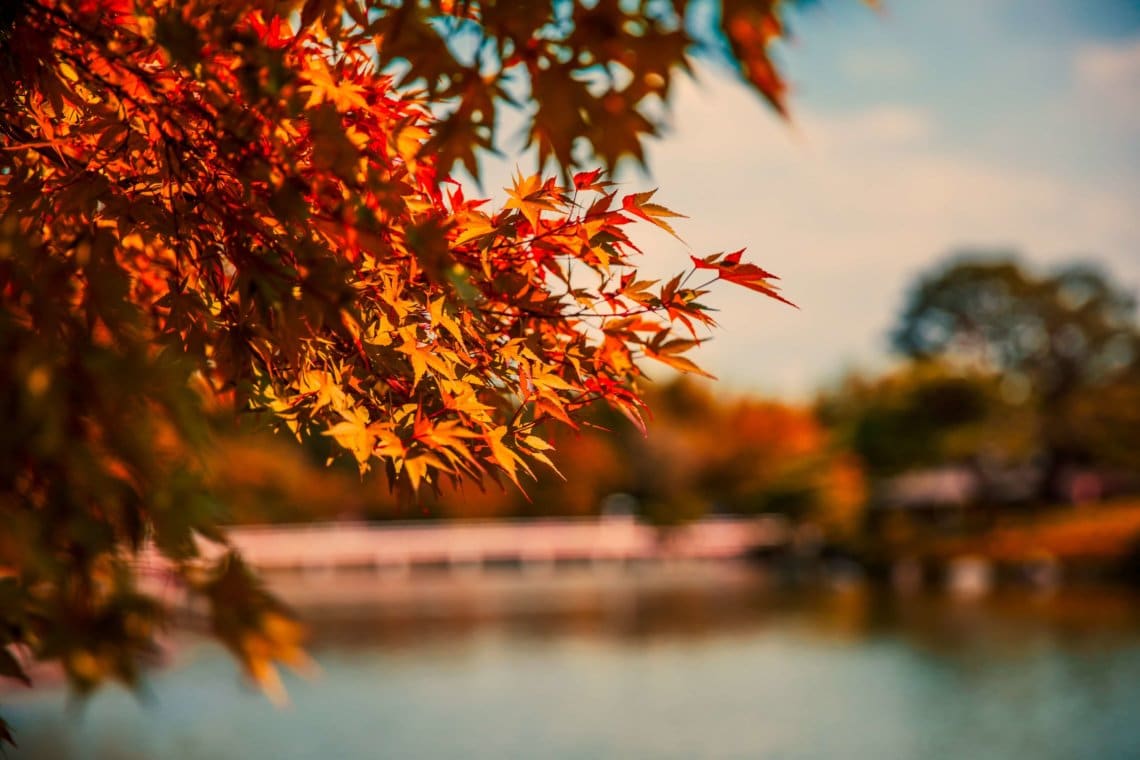
Fall in Japan
Autumn in Japan lasts from about mid-September to early December, depending on the location. Fall is widely considered to be the most pleasant time (weather-wise) to visit Japan, with temperatures ranging from approximately 50 to 70 °F (10 to 21 °C).
Apart from its comfortable temperatures and generally clear weather (particularly in later autumn), fall is perhaps most famous for the vibrancy of the changing foliage (koyo).
While autumn technically begins in late September, it’s still usually quite warm (sometimes very hot) at this time of year, but with the arrival of October the fall definitively gets underway.
With the pleasant change in weather, tourists also begin pouring in to enjoy the lovely temperatures, making October a very popular travel season in Japan. But its popularity doesn’t compare to November’s, when the peak autumn travel season begins. By November, autumn is in full swing, and throughout Japan you can begin to witness the fall foliage.

Tips on Visiting Japan in Fall
Due to the popularity of October and November, if you would like to try and avoid tourists to the extent possible, you may wish to consider early December, when you may still catch some of the koyo, though likely with fewer tourists around. Soaking in an outdoor onsen while gazing at the autumn foliage is also an unforgettable experience.
Japan’s fall foliage season is in many ways similar to cherry blossom season, in terms of the appeal and potential downsides (described in more detail above). As with hanami season travel, koyo travel means contending with more tourists, lower accommodation availability, higher accommodation prices, and a need to plan further in advance.
Please refer to our thoughts in the spring section above to get a better idea of whether fall (or spring) travel may be right for you.

Winter in Japan
Winter in Japan lasts from about December to mid-March, depending on the location. Winters are cold, with temperatures ranging from approximately 30 to 45 °F (-1 to 7 °C). Yes, it is cold, but if you can get past this basic fact (which is a potential “dealbreaker” for some), you’ll find that winter is in fact one of the best times to experience Japan all for yourself.
Aside from a few exceptions (described below), Japan – like many other destinations around the world – tends to receive fewer travelers during the cold winter season. This is partly because most people prefer to visit at more well-known times (such as cherry blossom season), and also in part because not everyone is able to utilize vacation days to visit at this time of year. This is unfortunate, especially if you are keen to experience Japan with fewer tourists around!
In the mountains of Japan, snowfall is especially plentiful, making Japan an incredible ski and snowboarding destination. The most well-known places to enjoy Japan’s legendary powder are Hokkaido and the Japan Alps (the latter played host to the 1998 Winter Olympic Games).
One of the best parts of visiting Japan in winter is the chance to really enjoy Japanese hot springs. While onsen can certainly also be enjoyed at other times of the year, nothing compares to sitting in a mountain hot spring, surrounded by a white landscape with snow falling on you as you soak. It’s one of the quintessential Japanese experiences, and not to be missed.

Tips on Visiting Japan in Winter
In general, you’ll find far fewer tourists visit Japan in winter, but there are some notable exceptions to keep in mind.
We receive lots of requests for travel around the New Year’s holidays, and while it can be a magical time to visit, it’s also worth considering the potential drawbacks. Because it’s an extended holiday period (not just in Japan, but in many places worldwide), the days before, during, and after New Year’s Day tend to become quite busy with both tourists from abroad, as well as Japanese people visiting family or taking vacations.
This means, for example, that the charming old streets of Kyoto will likely be bustling and full of people from around Japan and the world. For some, it’s a magical atmosphere, full of holiday spirit (Japanese style), but for those who prefer more peace and quiet it is worth a consideration.
Additionally, since Japanese people have several days off for the New Year’s holiday (far more than in places like the US or Europe), accommodations throughout the country are typically at very high occupancy, making availability low and prices higher than usual. Luxurious ryokans, in particular, tend to be booked up to a year or so in advance by “repeaters.”
As far as the New Year in Japan is concerned, it’s also important to point out that – from the end of December (generally sometime after Christmas) until a few days into January (usually until around January 3rd or 4th or later), many places are closed.
This can include (but is not necessarily limited to) some restaurants, museums, shops, and more. While there are increasing exceptions, in the past it’s been fairly reasonable to expect that most restaurants will be closed from at latest December 31st until at least January 2nd or 3rd (apart from certain high-end restaurants, as well as those located in department stores, hotels, and those catering particularly to travelers).
On the bright side, this can be a beautiful time to get off the beaten path and visit more remote areas of Japan. Additionally, most temples and shrines (for example, in Kyoto) do remain open around the New Year’s holiday, and thus it can in fact be a very peaceful and rewarding time of year to visit.

When Will You Visit Japan?
Deciding when to visit is often the first step in planning your Japan trip. We hope this guide has helped you form a clearer picture of what each of Japan’s seasons is like, and when would be ideal for you.
Japan is beautiful at any time of year, and we hope you have the chance to visit soon! If you’re interested in learning more about our service, make sure to check out our sample Japan itineraries.
